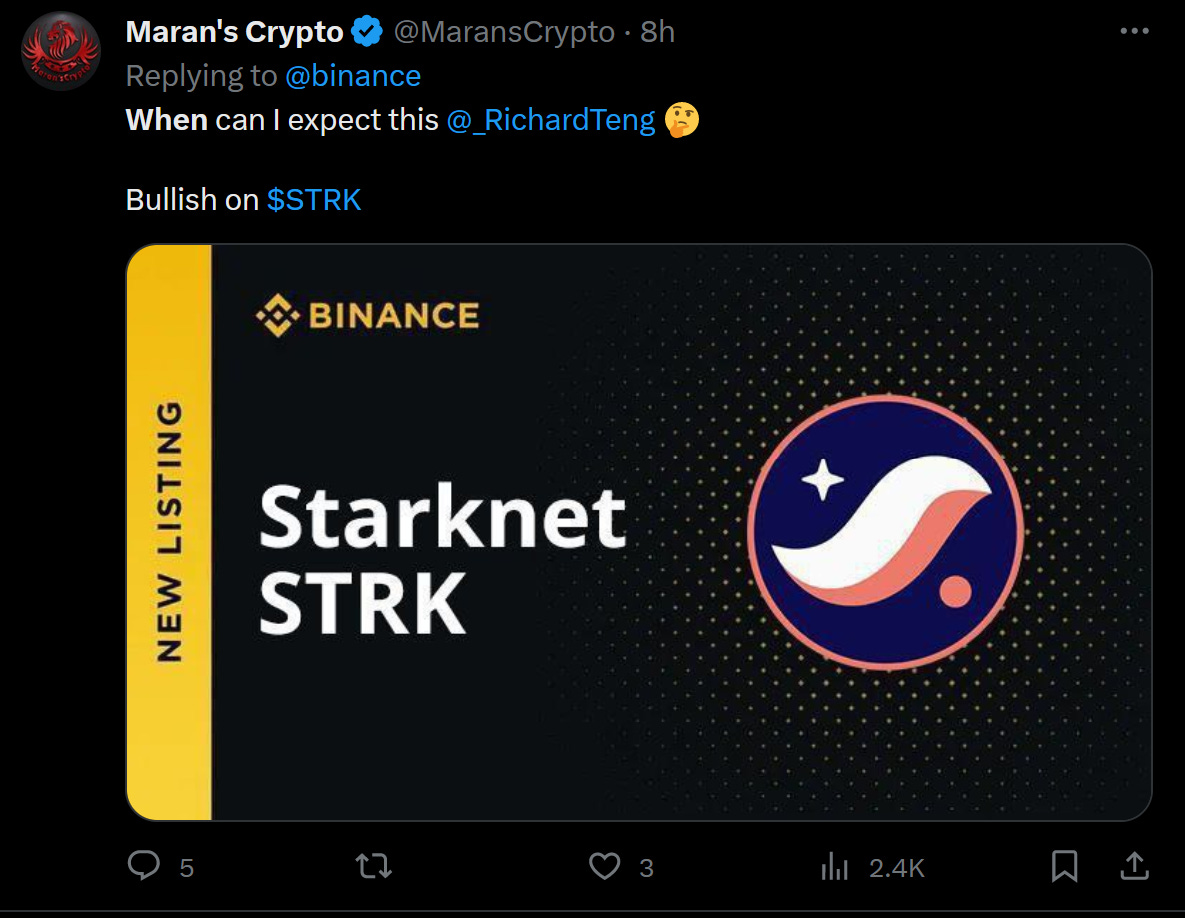Who is the real buyer of your token? 📈
Decoding Market Making and Insights from Bitbond's CEO on Token Management 🚀
Today's agenda...
Delve into the pivotal role of Market Makers in the crypto ecosystem, understanding token liquidation strategies like TWAP, and the meticulous selection criteria for a transparent partnership. 🔄💰
Explore the complexities of token management, along with valuable advice given by Bitbond’s CEO. 💡🌐
⏰ Reading time : 7 min
Join the Web3 Leaders Community
“When will we be listed on Binance?”
This question, often asked by newcomers to any Web3 project, raises a fascinating and often unknown paradox within the cryptocurrency ecosystem.
While Web3 is intended to be the standard-bearer for decentralization and autonomy, a striking irony emerges: centralization, although sometimes criticized, becomes an almost obligatory passage to gain visibility and credibility.
At the heart of this dynamic, Market Makers, key but often misunderstood players, play a pivotal role. This article aims to unveil their world, explore best practices, and identify pitfalls to avoid in this complex dance between centralization and decentralization. 💃🕺
Just a quick remember about liquidity
The liquidity of a token in the blockchain and cryptocurrency context refers to how easily it can be converted into other tokens or fiat currency without causing significant price fluctuations.
High liquidity means there is enough trading volume on the markets, allowing tokens to be bought or sold quickly 🏎️. This is crucial for investors and users, as high liquidity reduces the risk of loss when needing to sell in a hurry 🛡️.
Conversely, tokens with low liquidity can experience large price swings and may be difficult to sell quickly ⚠️.
Therefore, liquidity is a key indicator of a token's market health and stability 📊.
Roles and Functions of the Market Maker:
The Invisible Liquidity Builders Market Makers, true architects of the shadows, are indispensable for creating a market where tokens circulate with ease. Their crucial role in continuously supplying buy and sell orders through bots ensures the necessary liquidity for an efficient and active market. 🤖
Market Makers are the guarantors of the stability of token prices. By buffering extreme fluctuations, they give the markets predictability and reduced volatility, fundamental elements to attract and retain investors. 🛡️
👉 You understand that Market Makers will buy and sell your token. To operate, they will request a substantial volume of tokens and stable coins from you to place orders. 👉 It's also important to educate your community about these transfers, ensuring they understand the purpose and process behind them : it’s not liquidation and it creates value for them.
Token Liquidation & Market Making :
The majority of projects liquidate their tokens on the markets via their market maker, same person but different job. They often do it with the TWAP strategy.
The TWAP Strategy: A Trading Discipline The Time-Weighted Average Price (TWAP) is a refined tactic employed by Market Makers to execute large orders discreetly and measuredly. This strategy helps avoid market shockwaves by staggering transactions over a defined period. ⏱️
They are minimizing market impact by executing numerous small orders over time, rather than placing a single, large order at once.
👉 Adjust the TWAP strategy in response to the fluctuations of your token.
👉 Real-time information might be too complex for the community to understand. However, the most transparent projects typically share key figures with their community once or twice a year.
The Limit Not to Cross
Vigilance Against Market Manipulation Although Market Makers are vital, they navigate a fine line between providing liquidity and manipulation. Practices such as "wash trading," which consists of artificially inflating transaction volumes, although tempting, are not only unethical but also illegal. ⚠️
The Imperative of Transparency in market-making operations is crucial for preserving the integrity and trust around a Web3 project. Market Makers must align themselves with ethical and transparent practices. 🌟
👉 To get listed on major platforms, a significant level of liquidity in the token is required. As a result, many projects are tempted to artificially boost their volumes, albeit at their own risk.
👉 Platforms don’t give the exemple :
How to Choose a Market Maker:
A Meticulous Selection Choosing a Market Maker must be based on a careful evaluation of their reputation, expertise, and regulatory compliance. They must be in perfect harmony with the values and aspirations of the Web3 project. 🧐
A Partnership of Trust The Market Maker should be seen as a strategic partner, not just a service provider. This partnership must be founded on mutual trust and alignment of interests. 🤝
👉 Some Market Makers offer a trial period to assess the impact on liquidity and the clarity of their reports.
👉 Generally, it's better to pay them with a retainer fee to ensure alignment of interests.
Hope this helps!
The Power of Simplified Tokenization
A recent report by BCG and ADDX estimates that the potential of tokenization could grow 50x, reaching $16 billion by 2030:
Image credit : BCG, ADDX.
In a world where tokenization is the talk of the town, we've chosen to delve into the matter by interviewing the CEO of Bitbond, a company deploying a leading tokenization infrastructure. We seek insights from Bitbond's leader on the company's challenges and groundbreaking contributions to the evolving token landscape.
“In 2019, Bitbond was the first company to issue a security token in Germany with regulatory approval.”
Radoslav Albrecht - Founder and CEO of Bitbond
Chain Reaction : Could you share the tale of Bitbond's inception? Was it a eureka moment in the shower, or something more prosaic?
Radoslav Albrecht : The genesis of Bitbond can be traced back to a deep-seated belief in the transformative potential of blockchain technology. I envisioned a world where financial services were accessible, inclusive, and borderless, and I saw blockchain as the key to unlocking this potential. It was rather a culmination of ideas, discussions, and a shared passion for innovation. In 2013, we launched Bitbond as a P2P lending platform with a mission to democratize global access to working capital financing. In 2019, Bitbond was the first company to issue a security token in Germany with regulatory approval. We issued a tokenized bond called the “BB1” token.
That’s when we realized the potential of tokenization and decided to switch our business model to provide infrastructure for asset tokenization. The journey has been exhilarating, challenging, and immensely rewarding. Today our product Token Tool is a web3 app that enables users to effortlessly create, manage and multisend ERC20 / ERC1400 tokens and NFTs across leading EVM chains.
Managing tokens can be trickier than a cat herding contest. What are the biggest challenges and how does Bitbond make it look like a walk in the park?
Creating and managing tokens can indeed be complex. The decentralized nature of blockchain technology and the diversity of token types present unique challenges. There are three fundamental challenges:
Smart contract development is expensive: The know-how and resources to program secure token contracts efficiently are scarce.
Token lifecycle management is inconvenient: Deployment and lifecycle management (mint, burn, whitelist etc.) often require highly technical, manual processes
Key protection is unsecure: Insufficient key protection during deployment poses a high security risk for token issuers.
Token Tool presents a scalable infrastructure to ensure seamless token management tackling the challenges above. Users can rely on Token Tool’s configurable smart contract templates that have been audited by CertiK instead of having to program their own smart contracts. It offers a convenient user interface, as well as an API in its enterprise version. Banks, corporations, tech companies, and content creators alike use Token Tool to kick-start their tokenization projects.
What nuggets of wisdom would you offer to fellow Web3 CEOs trying to navigate the token tempest ?
In my opinion, Web3 founders and CEOs navigating the token tempest, should concentrate on the main objectives below:
Clarity of purpose: Clearly define the purpose and utility of your token. Understand the problem you're solving and the value you're offering to users.
Community engagement: Foster a strong and engaged community around your token. Listen to their feedback, address their concerns, and involve them in decision-making processes.
Regulatory compliance: Stay abreast of evolving regulations and ensure your token project adheres to all applicable laws. Seek legal counsel when necessary.
Long-term vision: Think beyond short-term gains and focus on building a sustainable token ecosystem. Create a roadmap with clear milestones and objectives.
Transparency and accountability: Be transparent about your tokenomics, usage, and distribution. Regularly update your community and stakeholders.
[…]
If you like our work, feel free to like and comment.
Follow us on Linkedin to keep up with all our news.
Disclaimer : The goal of this newsletter is to inform and produce content related to management in the world of Web3. It is not investment advice. Investments in crypto-assets and NFTs are risky and can result in the loss of your entire capital. Always conduct your own research and exercise caution.












